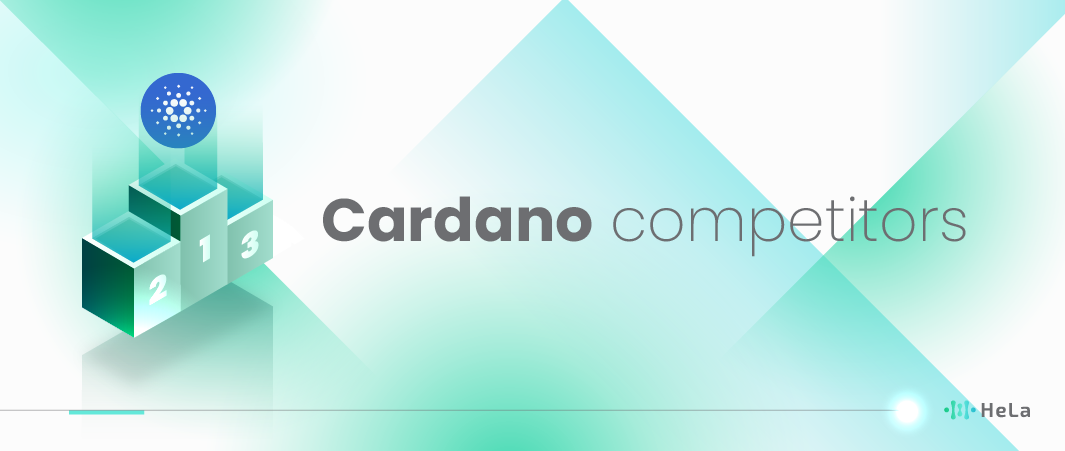In the ever-evolving landscape of blockchain technology, Cardano has emerged as a prominent player. But the field is competitive, with several platforms vying for the top spot. This article delves into the top seven competitors of Cardano, exploring their unique features and how they compare. Cardano, known for its research-driven approach and strong focus on sustainability, has set high standards in the blockchain arena.
However, innovation and technological advancements by its competitors pose new challenges and opportunities in the market. Understanding these competitors is crucial for anyone invested in the cryptocurrency space, whether you’re a developer, investor, or simply a tech enthusiast. This comprehensive guide aims to shed light on these platforms, their strategies, and their potential impact on the blockchain ecosystem.
Understanding Blockchain Competition

Blockchain technology has emerged as a revolutionary force in the world of finance, technology, and various other industries. Its significance lies in its ability to provide a decentralized, transparent, and tamper-proof ledger for recording transactions and managing data. This technology has the potential to disrupt traditional systems, offering solutions to longstanding issues like trust, security, and efficiency.
Competition within the blockchain sector is a driving force behind innovation and growth. It encompasses various aspects, including the development of new blockchain protocols, the creation of decentralized applications (DApps), and the proliferation of cryptocurrencies. The competition in the blockchain landscape can be analyzed from several angles:
- Protocol Development: Different blockchain platforms and protocols, such as Bitcoin, Ethereum, Binance Smart Chain, and Polkadot, compete to provide the most secure, scalable, and efficient solutions. These protocols continuously evolve to address weaknesses and introduce new features, which fosters innovation.
- Scalability: Blockchain networks are constantly striving to improve scalability to handle a greater number of transactions per second. Competition encourages developers to find creative solutions like layer 2 scaling solutions (e.g., Lightning Network for Bitcoin) or sharding (as proposed by Ethereum 2.0).
- Interoperability: As blockchain ecosystems grow, there’s a need for seamless communication between different blockchains. Projects like Cosmos and Polkadot are competing to provide interoperability solutions, enabling assets and data to flow freely between blockchains.
- Decentralized Finance (DeFi): DeFi projects are at the forefront of blockchain innovation, offering decentralized lending, borrowing, trading, and yield farming. Competition among these projects drives the development of novel financial instruments and strategies, attracting both users and developers.
- Non-Fungible Tokens (NFTs): The rise of NFTs has been a significant trend within blockchain technology, with artists, musicians, and creators using blockchain to tokenize and sell their digital content. Competition among NFT marketplaces and platforms fuels creativity and drives improvements in user experiences.
- Cryptocurrencies: The competition among cryptocurrencies like Bitcoin, Ethereum, and newer contenders like Solana or Cardano fosters innovation in terms of transaction speed, security, and governance models. Projects aim to offer unique features and benefits to users and investors.
- Regulatory Environment: Blockchain projects must also compete within the regulatory landscape, striving to adhere to evolving regulations while still providing the benefits of decentralization and privacy that blockchain technology promises.
Competition is a driving force in the blockchain sector, pushing projects and developers to continually innovate and improve their offerings. As the blockchain landscape evolves, we can expect to see more exciting developments and breakthroughs that have the potential to reshape various industries beyond finance, including supply chain management, healthcare, and governance. The continued interplay of competition and innovation will play a crucial role in shaping the future of blockchain technology.
Also Read: 7 Best Blockchains for NFT to Consider in 2025
The Evolution of Cardano and Its Impact
Cardano, often referred to as ADA, has embarked on a remarkable journey in the world of blockchain technology. Founded by Charles Hoskinson, one of the co-founders of Ethereum, Cardano was designed to address some of the most pressing challenges facing the blockchain industry. In this section, we will explore the key milestones in Cardano’s evolution, its unique selling propositions, and the profound impact it has had on the blockchain market.
Genesis and Research-Driven Approach
Cardano’s journey began in 2015 with the formation of Input Output Hong Kong (IOHK), a blockchain research and development company led by Charles Hoskinson. What sets Cardano apart from many other blockchain projects is its rigorous, research-driven approach. Before writing a single line of code, Cardano’s team conducted extensive academic research to lay a solid theoretical foundation for the project. This approach is rooted in peer-reviewed academic papers and a commitment to formal methods, ensuring a high level of security and robustness.
Layered Architecture
Cardano’s unique selling proposition lies in its layered architecture. The platform is divided into two main layers: the Cardano Settlement Layer (CSL) and the Cardano Computation Layer (CCL). CSL serves as the foundational layer for ADA transactions, while CCL is designed to support smart contracts and decentralized applications (DApps). This separation allows for greater flexibility and scalability, as updates or changes can be made to one layer without affecting the other.
Ongoing Development and Upgrades
Cardano’s development is characterized by a series of carefully planned phases. These phases include Byron, Shelley, Goguen, Basho, and Voltaire. Each phase brings specific improvements and features to the platform, with Shelley marking a significant milestone as it introduced staking and decentralization. Goguen, on the other hand, added smart contract functionality, opening the door to a wide range of DApps and DeFi applications on Cardano.
Environmental Impact and Sustainability
Cardano has also made waves in terms of sustainability and environmental impact. Unlike many other blockchain networks that rely on energy-intensive consensus mechanisms like Proof of Work (PoW), Cardano uses a more energy-efficient Proof of Stake (PoS) mechanism. This not only reduces the carbon footprint but also aligns with the growing global focus on sustainable blockchain solutions.
Influence on the Blockchain Market
Cardano’s influence on the blockchain market cannot be understated. Its commitment to academic rigor and peer-reviewed research has set a new standard for blockchain projects. Moreover, its layered architecture and focus on sustainability have inspired other projects to explore similar approaches. Cardano’s presence in the DeFi space is also growing, with an increasing number of projects and developers choosing to build on its platform.
Cardano’s journey from its research-driven beginnings to its impact on the blockchain market showcases the importance of innovation, sustainability, and a commitment to academic excellence. As it continues to evolve through its development phases, Cardano is poised to play a significant role in shaping the future of blockchain technology and its applications.
7 Best Cardano Competitors & Alternatives in 2025

In the dynamic and ever-evolving realm of blockchain and cryptocurrency, Cardano stands as a formidable player with its focus on scalability, sustainability, and smart contract capabilities. However, the competitive landscape is rich and diverse, with several blockchain platforms vying for supremacy. In this list, we delve into the best Cardano competitors, each offering its unique strengths and innovations.
1. HeLa Labs
HeLa Labs is spearheading innovation in blockchain technology with their Layer-1 protocol, which is designed to be modular and scalable, addressing key issues in blockchain technology such as interoperability and flexibility. This protocol is not only EVM compatible, but also emphasizes security with its unique consensus mechanism.
Moreover, HeLa’s approach integrates decentralized digital identity management, and it stands out for its inclusion of a fiat-backed stablecoin, which is a significant step towards bridging the gap between traditional finance and the blockchain world.
2. Ethereum
Ethereum has been a trailblazer in the blockchain space, primarily known for its role in pioneering smart contracts and decentralized applications. Its Ethereum Virtual Machine (EVM) has become a standard in the industry, supporting a wide range of applications and innovations. In addition, Ethereum is undergoing significant upgrades, such as the transition to Ethereum 2.0, which aims to improve scalability and energy efficiency, further solidifying its position as a foundational platform in the cryptocurrency ecosystem.
3. Polkadot
Polkadot offers a distinctive approach to blockchain technology, focusing on interoperability and scalability. Its architecture allows different blockchains to connect and interact seamlessly, which solves critical issues like scalability and fragmented ecosystems. This ‘network of blockchains’ concept enables various blockchains to maintain their independence while still working cohesively, which is crucial for the future development of the blockchain industry.
4. Solana
Solana is renowned for its impressive transaction speeds and low costs, making it a competitive platform in the DeFi and DApp sectors. The unique combination of Proof of History (PoH) and Proof of Stake (PoS) in its consensus mechanism contributes to its high throughput. This efficiency and scalability make Solana an attractive option for developers and users who prioritize performance in blockchain applications.
5. Binance Smart Chain (BSC)
Developed by the largest cryptocurrency exchange, Binance, BSC is a high-performance network that supports advanced decentralized applications and smart contracts. Its compatibility with the Ethereum Virtual Machine (EVM) allows for seamless integration and interoperability with Ethereum’s network, which is crucial for developers who build on both platforms. BSC’s focus on performance and user experience has made it a popular choice in the blockchain community.
6. EOS
EOS is designed with user-friendliness and scalability in mind, aiming to solve prevalent issues in blockchain technology. Its unique governance model and capacity for handling thousands of transactions per second make it well-suited for large-scale decentralized applications. The EOS platform is particularly notable for its emphasis on providing a seamless and efficient user experience, which is essential for mainstream adoption of blockchain technology.
7. Algorand
Algorand is recognized for its speed and efficiency, particularly in financial applications and broader blockchain use. Its Pure Proof of Stake (PPoS) consensus mechanism ensures decentralization, security, and quick transaction processing. Algorand’s focus on minimal transaction fees and efficient processing makes it a strong contender in various blockchain applications, extending beyond just financial transactions.
The Future of Blockchain Competition
As we delve into the future of blockchain technology, it becomes evident that this innovative field is poised for significant growth and evolution. This part of our discussion will explore the trends and potential technological advancements that lie ahead, and what they mean for platforms like Cardano and its competitors.
- Scalability: One of the primary challenges that blockchain platforms currently face is scalability. As more users and businesses adopt blockchain for various purposes, the demand for faster and more efficient transactions will continue to rise. Future developments in consensus algorithms and layer 2 solutions are expected to address these scalability issues, making blockchain networks more attractive for mass adoption. Cardano, like many other blockchain platforms, will need to adapt and implement these solutions to remain competitive.
- Interoperability: The blockchain ecosystem is highly fragmented, with multiple platforms operating independently. However, the future may bring increased interoperability between different blockchain networks. This could lead to a scenario where assets and data can move seamlessly between various blockchains. Cardano’s success may depend on its ability to establish partnerships and interoperability with other major blockchain networks.
- Smart Contracts and Decentralized Finance (DeFi): Smart contracts and DeFi have been instrumental in driving the growth of the blockchain industry. The future will likely see even more sophisticated and complex smart contracts, enabling a wider range of decentralized applications (dApps). Cardano, with its focus on smart contracts and DeFi capabilities, will need to continue innovating to stay competitive in this space.
- Environmental Sustainability: Environmental concerns related to the energy consumption of blockchain networks have gained prominence. Future blockchain solutions may prioritize energy efficiency and sustainability. Cardano’s approach to consensus, which is based on proof-of-stake (PoS), positions it well in this regard. As the world becomes more eco-conscious, platforms with sustainable practices may gain a competitive edge.
- Regulatory Frameworks: Blockchain technology is still in its early stages, and regulatory frameworks are constantly evolving. The future will likely bring more comprehensive regulations to the blockchain space, aimed at ensuring consumer protection and security. Platforms like Cardano will need to adapt to these regulatory changes and work closely with authorities to remain compliant.
- Privacy and Security: Privacy and security concerns will continue to be paramount in the blockchain industry. Advancements in privacy-focused technologies like zero-knowledge proofs and secure multi-party computation may become integral to blockchain networks. Cardano, like its competitors, will need to invest in these areas to enhance user confidence.
- Global Adoption: The future of blockchain competition also hinges on global adoption. The platform that can successfully expand its user base across different regions and markets will have a significant advantage. This requires a strong international presence, partnerships with local businesses, and a deep understanding of cultural and regulatory nuances.
The future of blockchain competition holds exciting possibilities and challenges. Cardano, along with its competitors, must remain agile and innovative to stay relevant in this rapidly evolving landscape. The ability to adapt to emerging trends, integrate new technologies, and navigate regulatory changes will be key factors in determining the long-term success of blockchain platforms in the years to come.
How to Stay Updated in the Fast-Paced World of Cryptocurrency

Staying updated in the fast-paced world of cryptocurrency is crucial to make informed decisions and navigate the ever-changing landscape effectively. Below are some valuable tips and resources to help you stay informed about the latest developments in the blockchain and cryptocurrency space:
Follow News Websites and Blogs
Start by regularly visiting cryptocurrency news websites and blogs. Some reputable options include CoinDesk, CoinTelegraph, The Block, and Decrypt. These platforms provide daily updates on market trends, regulatory changes, and new project launches.
Subscribe to Newsletters
Many crypto news outlets offer newsletters that deliver top stories and insights directly to your email inbox. Subscribing to these newsletters can help you stay informed without having to actively seek out information.
Follow Influential Figures
Twitter and other social media platforms are home to numerous influential figures in the cryptocurrency space. Follow experts, analysts, and key industry players to get real-time updates and valuable insights. Some notable figures include Vitalik Buterin (Ethereum), CZ (Binance), and Andreas M. Antonopoulos.
Join Cryptocurrency Forums and Communities
Engaging in online cryptocurrency communities like Reddit’s r/CryptoCurrency and BitcoinTalk can provide you with valuable information and discussions. These platforms are also great for asking questions and sharing your own insights.
Utilize Cryptocurrency Apps
There are various mobile apps available that provide real-time cryptocurrency price tracking, news updates, and portfolio management. Some popular apps include Coinbase, Blockfolio, and CoinMarketCap.
Listen to Podcasts
Cryptocurrency podcasts offer in-depth discussions on various topics within the crypto space. Consider subscribing to podcasts like “Unchained” by Laura Shin or “The Crypto Street Podcast” for regular updates and interviews with industry experts.
Attend Webinars and Virtual Events
Keep an eye out for virtual conferences, webinars, and online events in the cryptocurrency space. These events often feature prominent speakers and provide insights into the latest developments.
Read Whitepapers
For a deeper understanding of specific cryptocurrencies and blockchain projects, read their whitepapers. These documents provide detailed information about the technology, goals, and vision of a project.
Stay Informed on Regulatory Changes
Cryptocurrency regulations can vary greatly by region and can significantly impact the industry. Stay updated on regulatory changes in your jurisdiction and globally to anticipate potential impacts on the market.
Use Cryptocurrency Analytics Tools
Platforms like Glassnode and IntoTheBlock provide advanced on-chain analytics and metrics to help you gain a deeper understanding of blockchain data and market trends.
Join Cryptocurrency Slack and Telegram Groups
Many blockchain projects and cryptocurrency communities operate on messaging platforms like Slack and Telegram. Joining these groups can give you direct access to project updates and discussions.
Also Read: What Is Parallel Execution? A Detailed Overview
Diversify Your Sources
Avoid relying on a single source of information. Diversify your information intake to get a more comprehensive view of the cryptocurrency landscape.
Learn Continuously
Cryptocurrency and blockchain technology are constantly evolving. Consider taking online courses, reading books, and participating in online seminars to deepen your knowledge and stay ahead of the curve.
In summary, staying updated in the world of cryptocurrency requires a multifaceted approach. Combining various sources, engaging with the community, and continuously educating yourself will help you make informed decisions and navigate the dynamic cryptocurrency market successfully.
Conclusion
In conclusion, the blockchain landscape is marked by intense competition and continuous innovation. Each of these competitors brings something unique to the table, challenging Cardano in different ways. As the industry evolves, it is crucial to keep an eye on these developments. Whether it’s through technological advancements, strategic partnerships, or community growth, the dynamics between these platforms will shape the future of blockchain technology.
Finally, for enthusiasts, developers, and investors in the blockchain space, understanding these competitors is not just about knowing the market. It’s about grasping the potential of blockchain technology and its ability to revolutionize various sectors of our world.
Disclaimer: The information provided by HeLa Labs in this article is intended for general informational purposes and does not reflect the company’s opinion. It is not intended as investment advice or recommendations. Readers are strongly advised to conduct their own thorough research and consult with a qualified financial advisor before making any financial decisions.

Joshua Soriano
I am a writer specializing in decentralized systems, digital assets, and Web3 innovation. I develop research-driven explainers, case studies, and thought leadership that connect blockchain infrastructure, smart contract design, and tokenization models to real-world outcomes.
My work focuses on translating complex technical concepts into clear, actionable narratives for builders, businesses, and investors, highlighting transparency, security, and operational efficiency. Each piece blends primary-source research, protocol documentation, and practitioner insights to surface what matters for adoption and risk reduction, helping teams make informed decisions with precise, accessible content.
- Joshua Soriano#molongui-disabled-link
- Joshua Soriano#molongui-disabled-link
- Joshua Soriano#molongui-disabled-link
- Joshua Soriano#molongui-disabled-link

